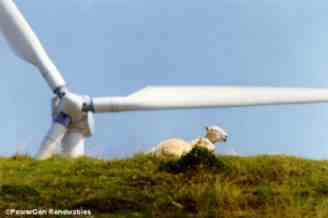|
What They Are Saying About Wind Energy
8 August 03
Greens New Web
Site Urges The Highlands to Say Yes To Wind
Highlands Asked To Log On As Campaigners Fight For Clean Energy
Green groups have launched a website that calls on people to
join the campaign to increase the amount of energy supplied by wind
power in the UK. the groups are so concerned by misinformation
about wind power which is circulating on the internet that they have
joined forces to launch
www.yes2wind.com.
Environmentalists say the technology can boost jobs and tourism
while fighting climate change - the world's biggest environmental
problem.
Greenpeace, Friends of the Earth and WWF-UK - are determined to
counter internet propaganda which has spread scare stories about
planned wind farm developments. The green groups are keen to
promote the new site in The Highlands where a vocal minority has
been oppose the development of clean, green energy generation.
Opinion polls show the vast majority of people support the building
of wind farms but anti-wind websites and leaflets have responded
with biased and unreliable information.
The new site shows how wind farms are a key part of the UK's efforts
to tackle climate change and can increase investment, create jobs
and attract tourists, as well as reducing air pollution. This
technology has the potential to greatluy reduce the Uk's dependence
on fossil fuels like coal and gas.
www.yes2wind.com
is offering prizes to Highlands residents who send them the most
outrageous myths put out by anti-wind groups, for example some
anti-green campaigners have made unfounded claims that wind turbines
can spark epileptic fits and cause grass fires.
The new site aims to build a nationwide network of pro-wind
campaigners. Oxfordshire farmer Adam Twine offers advice on
how to get a pro-wind campaign off the ground, while an electronic
noticeboard lets activists in rural areas share tactics and discuss
issues. Posters and leaflets can be downloaded and experts
contacted for advice.
Emily Armistead of Greenpeace said: " Europe's current extreme
weather shows that climate change is already with us. wind
power is an urgently needed, clean solution to global warming.
We need people in the Highlands to support wind power in their area
now. yes2wind.com offers loads of ways to do this".
 Scottish Power Scottish Power
The Windiest Place In Europe
- Leaflet on Wind Farms
Scotland is the windiest
country in Europe with an average windspeed of more than 7.5 metres
per second (at 50 metres altitude) – yet this rich resource is under
exploited. Denmark has around 2,000 MW of wind energy
capacity, mostly onshore, and has recently embarked on a major
offshore programme which aims eventually to meet half of the
country’s energy needs by wind power. Countries such as Spain and
Germany are also ahead of the UK in utilising wind energy, despite
lower levels of wind speed. However, Scottish Power’s ambitious
programme of wind farm development is indicative of a new emphasis in
this country on renewable energy generation.
European wind energy breaks the 20,000MW barrier
13th November 2002
40% growth rate over last 12 months
- British Wind Energy Association
Germany is leading the European expansion, commissioning 1,896
MW of wind energy in the first nine months of 2002, with Spain in
second place with 742 MW. Countries which have made good progress
after a relatively quiet spell include the Netherlands. France moved
into tenth place in the league table with 131 MW. Austria celebrated
its 100 MW landmark on the back of one of the highest situated wind
farms in the world, at 1,900 metres in the Styrian Alps. "With
50 per cent of European wind capacity, the wind power boom in
Germany is set to continue," said Millais. "The German Government
announced at the latest climate talks in India last month that it
wants a 40 per cent cut in greenhouse gases by 2020 in Germany, and
a 30 per cent cut throughout Europe by 2020. Wind energy has proven
itself to be one of the most powerful technology solutions for
tackling climate change". A total of 84 per cent of European
wind energy capacity is installed in Germany, Spain and Denmark.
Wind energy now accounts for 4 per cent of national electricity
consumption in Germany, and 18 per cent in Denmark. About 80 per
cent of all wind turbines sold worldwide are manufactured by
European companies. |
 Scottish Power
Scottish Power